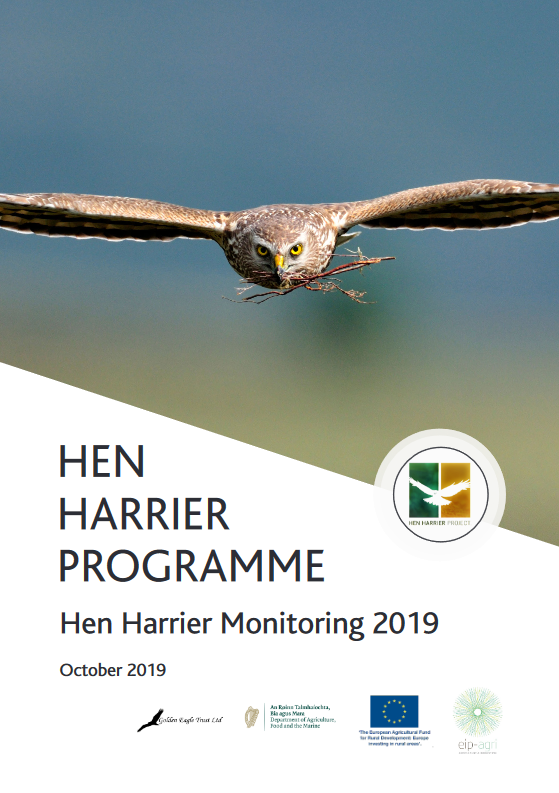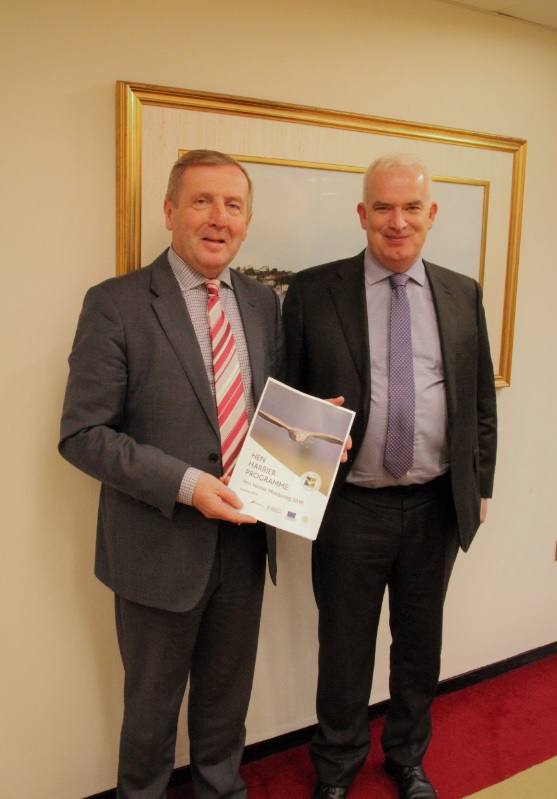
Creed welcomes Hen Harrier breeding success
https://www.agriculture.gov.ie/press/pressreleases/2019/november/title,135235,en.html
Payments to farmers for 2019 Scheme commencing this week
The Minister for Agriculture, Food and the Marine, Michael Creed T.D., welcomed the Hen Harrier Monitoring report for 2019 which is showing a 35% increase on the 2017 figure in the number of young hen harriers fledged. The 81 chicks fledged this year is the highest such number in 14 years. The Hen Harrier Project funded by the Department of Agriculture, Food and the Marine has contributed to this success. This Project is a locally-led, locally-designed and locally-administered scheme, funded under the DAFM’s Rural Development Programme. Hen Harrier monitoring was carried out by the Golden Eagle Trust working with the Hen Harrier Project team.
The report was presented to Minister Creed by the Hen Harrier Project Manager, Fergal Monaghan who also updated on the progress of the project. Speaking after the presentation the Minister said “I was delighted to see the increase in fledged hen harrier chicks this year. The considerable investment by my Department in the Hen Harrier project, and particularly the actions of the 1,524 participating farmers have contributed to this achievement. Together these participants manage over 37,000 hectares across all 6 Special Protection Areas and make a huge contribution to this biodiversity priority. Their actions in providing improved quality habitat for the birds have led to an improvement in the breeding success of the hen harrier population. The overall situation is still critical and there is no room for complacency, but we are moving in the right direction.”
This was echoed by the Hen Harrier Project Manager, Fergal Monaghan, who said “it has been a very productive year for hen harriers. A total of 81 chicks left the nest in 2019, up 35% on the number recorded in 2017 when the Hen Harrier Project commenced, and the highest figure recorded since the first SPA survey in 2005.”
Minister for Culture, Heritage and the Gaeltacht, Josepha Madigan T.D., also welcomed the substantial increase in fledging hen harrier in 2019; “I am looking forward to my Department’s continuing involvement in the Hen Harrier Project and other initiatives to improve the conservation status of the species. I note that the forthcoming Hen Harrier Threat Response Plan, currently being finalised by my Department in consultation with the Department of Agriculture Food and the Marine, the Department of Communications, Climate Action and Environment and the Department of Housing, Planning and Local Government, will set out actions for all sectors aimed at improving the long term prospects of the species.”
Minister Creed also welcomed the commencement of 2019 habitat payments to farmers under the Hen Harrier Programme. Some 1,500 participating farmers will be receiving approximately €3 million in payments between now and the end of the year.
Minister Creed also confirmed that payments to 328 farmer participants in the Burren Programme have already begun and will continue on a weekly basis. It is expected that more than €700,000 will be paid to participating farmers in the form of habitat-based payments before the end of the year. Payment to the Pearl Mussel Project participants will also commence shortly and it is expected that over €900,000 will be paid to 342 participants by the end of 2019.
Minister Creed concluded stating, “these locally-led projects are one of the real success stories of our Rural Development Programme and I congratulate all the projects on their ongoing good work. I would encourage all stakeholders to engage in the consultation process currently underway to prepare for the next Common Agricultural Policy, and help shape the future of locally-led schemes and agri-environment policy”.

[registration_form]Hen Harrier Programme
https://www.agriculture.gov.ie/press/pressreleases/2019/november/title,135235,en.html
The Monitoring Report can be found at http://www.henharrierproject.ie/HHP_HH_Monitoring_2019.pdf
The Hen Harrier Programme is a scheme under the Department of Agriculture, Food and the Marine’s Rural Development Programme. It is a locally-led, locally-designed and locally-administered scheme under a Project Management Team based in Co Galway.
It is a 5-year programme and focuses specifically on farmers managing land in the six Hen Harrier SPAs – Slieve Beagh, Slieve Bloom Mountains, Slieve Felim to Silvermines Mountains, Slieve Aughty Mountains, Stacks to Mullaghereirk Mountains, West Limerick Hills & Mount Eagle and Mullaghanish to Musheramore Mountains Special Protection Areas (SPAs).
The Hen Harrier Programme commenced in April 2017 and has 1,524 participants.
The habitat payment is the first of three payments streams under which the participants can benefit.
Burren Programme
The Burren Programme is a locally-led agri-environmental scheme, co-financed by the Department of Agriculture, Food and the Marine and the EU, which works with farmers to help them to conserve the Burren’s environment whilst allowing them to continue producing quality livestock. It was developed in the Burren, for the Burren, by working with local farmers during Burren LIFE and the Burren Farming for Conservation Programme.
Pearl Mussel Project
The Pearl Mussel Programme is the second largest of The European Innovation Partnerships Initiative (EIP)/locally led schemes scheme after the Hen Harrier programme.
The programme is targeted specifically at farmers with designated land in the eight SPA pearl mussel catchments. The catchments included in the Pearl Mussel Programme are: Blackwater, Caragh and Currane in County Kerry, Ownagappul in County Cork, Bundorragha in County Mayo, Dawros and Owenriff in County Galway and Glaskeelan in Co. Donegal.
The programme is a collaborative effort and the Pearl Mussel Team are supported by an extensive team of hydrologists, ecologists, fieldworkers and farm advisors who will support the roll-out of the programme on the ground. DAFM, with the National Parks and Wildlife Service of the Department of Culture, Heritage and the Gaeltacht, EPA, Teagasc, LAWSAT and other experts help guide and support the project.
ENDS
,Would you believe it, they sound like they really know what they’re talking about, like it’s a scheme which is working and that they truly believe in what they’re doing. They’re chuffed with the results and committed to doing even better. Wow, if only we had politicians like that instead of the compromised bunch over here.
If I have understood this blog correctly it is showing how well the Hen harriers are recovering in Ireland when the Irish Government works with its farmers, land owners and conservation organisations to help the Hen Harriers recover.
What a difference and contrast to the U.K. where the UK Government is locked in a Victorian and antediluvian attitude towards hen harriers and other upland wildlife because of its vested interests in driven grouse shooting and game bird shooting generally.
In a previous comment on a blog I asked the rhetorical question, is this Government prepared to work with the RSPB and others to help our wildlife. The answer is clearly no when compared to what the Irish Government are doing.
This Irish report just shames our own Government even more than they should be ashamed already. They are a total disgrace. and not worthy or the word Government.
I hope those 81 fledged harrier chicks have the good sense to not venture across the Irish Sea and try their luck on an English grouse moor.
I have quickly read this but haven’t seen mention of any satellite tags being fitted to these 81 fledged Hen Harriers, but I could easily have missed it.
It would be interesting to know how many of these birds wander across the Irish Sea into Great Britain.
If tags are fitted I wonder which ones are used?
tperry – good points
Sounds great on paper.
But you GB folks have been duped into thinking the HH is secure in Ireland. It’s really not. 81 chicks for the whole of Ireland is not a lot at all when you think about it given the amount of bog, upland and rough ground we have.
What the report doesn’t tell you is how more HH are nesting outside the SPAs because most of the SPAs have been blanketed in Sitka spruce. It doesn’t tell you how the government have made a commitment to continue planting Sitka across the SPAs – see http://henharrierireland.blogspot.com/2017/10/forestry-and-hen-harriers-in-ireland.html?m=1. It also doesn’t mention how wind turbines are often placed in HH nesting sites and ignoring important land designations.
A number of chicks are tagged in Ireland each year but survival rates are low. As far as I am aware there are very few ‘missing, not recovered’ tagged birds. Not to say persecution doesn’t happen here of course.
A better situation than England for sure, but there’s as much that this report doesn’t say.
Jim – many thanks for filling in some of the gaps for us.
I dont know what the payments amount to in the Republic, but to translate it to the UK, it would
have to be a very great deal, to be anywhere near effective.
The perceived worth, £150/ 200, of a brace of Red Grouse chicks,would take a lot to overcome.